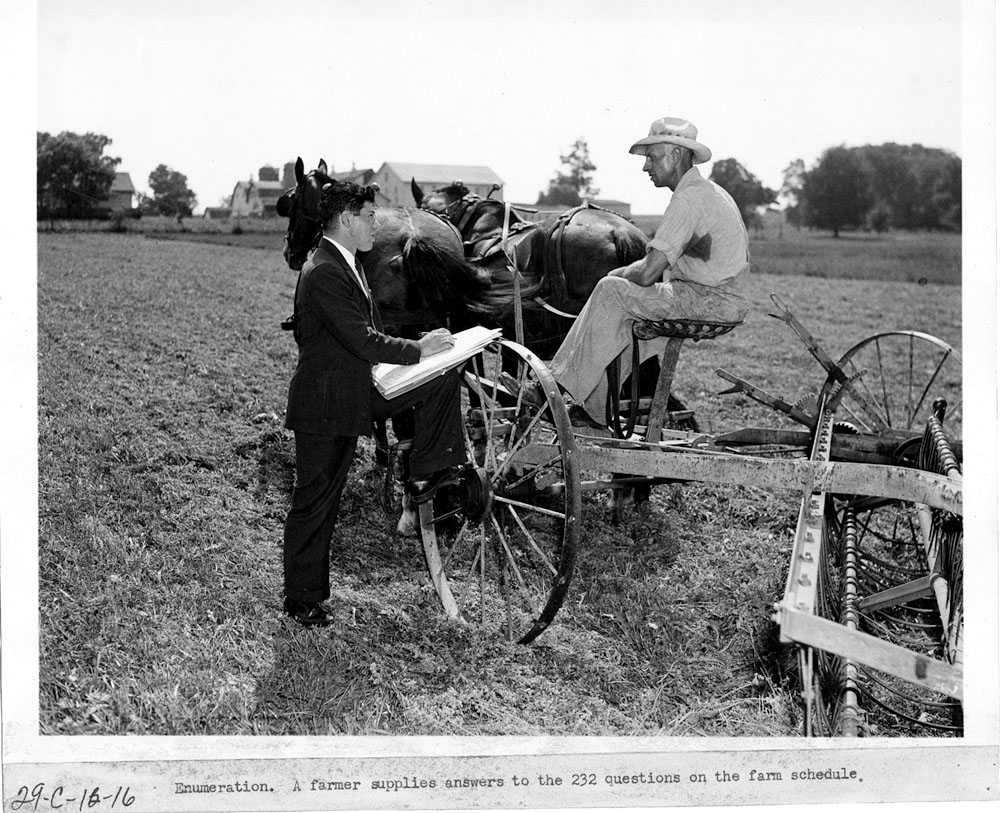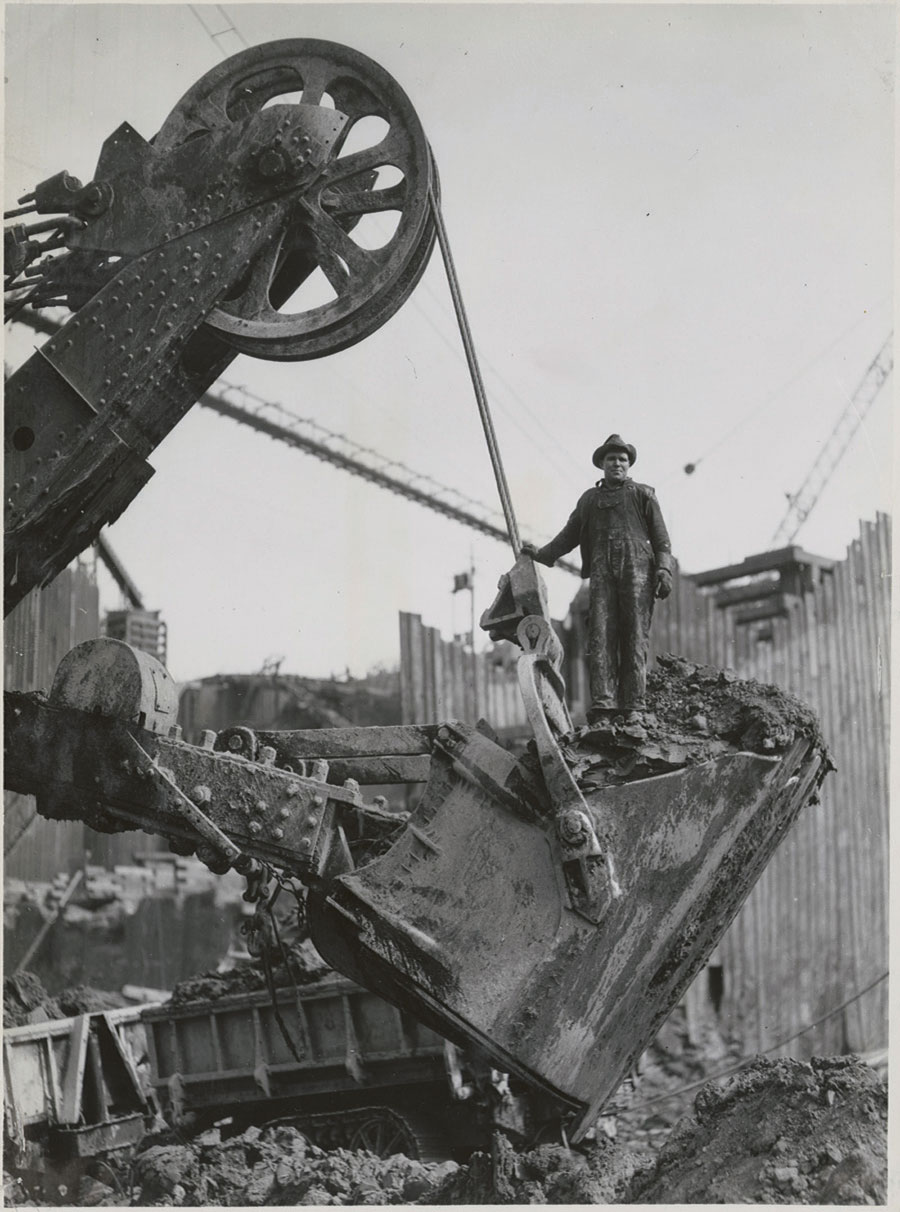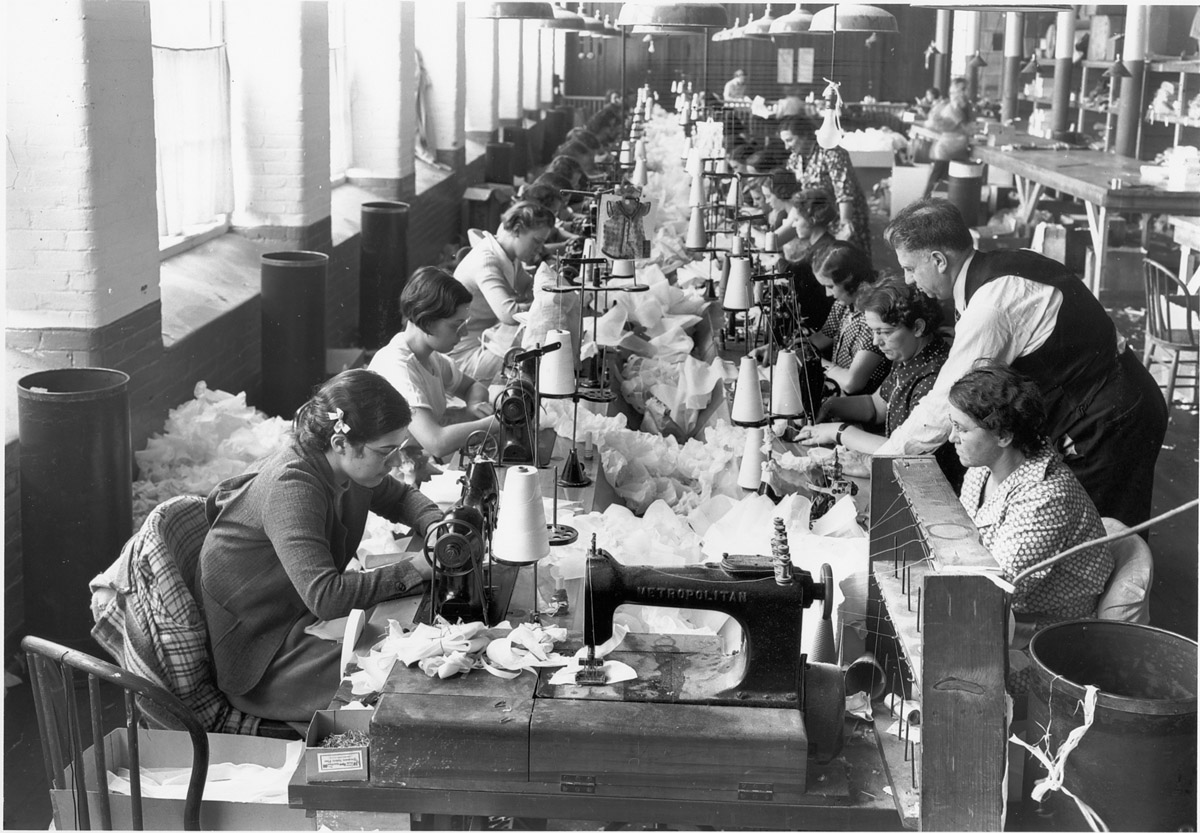
Brother, Can You Spare a Dime?
The 1940 Census: Employment and Income
Spring 2012, Vol. 44, No. 1 | Genealogy Notes
By Diane Petro
"This year's census falls on the 150th anniversary of census-taking in America. . . . [V]ital new statistical knowledge will be developed by questions on education, mass migration, employment, unemployment, occupation and distribution of wages and salaries."
The opening of the 1940 population census this year gives us a window onto life in the United States during the Great Depression and the years immediately before involvement in World War II. Natural disasters compounded economic hardships as drought and wind created a "Dust Bowl" in the center of the country. This was a decade of great change for the country, and the questions asked on the census allow the people themselves to tell us about the social and economic issues they faced.
The 1940 census gathered an extensive amount of information related to employment and income. Some of the new questions are
- How many weeks have you been unemployed?
- Are you working at your usual occupation?
- How much did you earn in 1939?
For 72 years the answers to those questions have been protected by privacy laws, but now this rich source of personal and cultural information is open to all researchers.
The 16th decennial census of population began on April 1, 1940. The average income was $1,368, and the average unemployment rate in the 1930s was 18.26 percent, up from the average of 5.2 percent in the 1920s. Earlier censuses primarily measured the expansion of the country quantitatively in population, territory, and resources, but for the 1940 census, officials felt that they should gather information that would throw light on the internal social and economic problems facing the nation.
Many families in the hard-hit "Dust Bowl"—covering parts of Nebraska, Kansas, Colorado, New Mexico, Oklahoma, and the Texas Panhandle—were forced to abandon the land and join the ranks of migrant workers toiling for low wages on distant commercial farms. The migrant flow out of the region included people from cities and small towns and farmers who had been replaced by motorized farm machinery.
The questions on employment status pertain to the week of March 24–30, 1940, and include only people who were at work, with a job, seeking work, or on public emergency work during that week. A difference from earlier censuses is in the definition of at work and gainful workers. In earlier censuses, gainful workers were persons reported as having an occupation, regardless of whether they were working at the time of the census. For example, if Grandpa Hedges was a seasonal worker, but not working or seeking work at the time of the census, he would have been included among gainful workers in 1930. But in general, he would not be in the 1940 workforce.
Employment questions start in column 21. Because of widespread government projects during this period, there are two categories of work: those at work for pay or profit and those on public emergency work during the week of March 24–30, 1940.
Column 21 "Was this person AT WORK for pay or profit in private or nonemergency Govt. work during week of March 24-30, 1940?" (Y or N)
A "yes" in this column means the person was available to work, full-time or part-time during the week. Column 26 then indicates the number of hours the person worked during that week. On occasion, the number of hours worked is zero, even when there is a yes in column 21. For example, a doctor or lawyer may have been available at any time during the week but may not have performed any service or received any fees.
Sometimes the letters "Inst." appears in column 21. This indicates the person is an inmate of one of the following public or private institutions: prisons reformatories; jails; penal farms or camps; institutions for the mentally diseased, mentally defective, or epileptic; and homes for the aged, infirm, or needy. The 1940 census did not count anyone in institutions as being in the workforce even if they were at work. This is different from previous censuses. When "Inst." is in column 21, all other columns should be blank.1
Column 22 "If not, was he at work on, or assigned to, public EMERGENCY WORK (WPA, NYA, CCC, etc.) during week of March 24–30?" (Y or N)
When the reported numbers were totaled, the Census Bureau noted a discrepancy between the total number of persons reported on emergency work and the number recorded on the federal emergency payroll.2
Misclassification of persons on public emergency work occurred when
- people were enumerated at work rather than as on public emergency work, or
- people were reluctant to report they were on emergency work.
Column 23 "Was this person SEEKING WORK?" (Y or N)
The seeking work category represents persons without work of any sort in the week of March 24–30, 1940, who were actively seeking work during that week.
Column 24 "If not seeking work, did he HAVE A JOB, business, etc.?" (Y or N)
"Yes" appears if the person had a job, businesses, or a professional enterprise but was was temporarily absent from it the week of March 24–30. It also includes people who were temporarily ill but had a job to return to upon recovery. Only 2.5 percent of the population reported having a job but not being at work.
Questions 25–27 cover those not in the workforce, hours worked, and unemployment.
Column 25 "Indicate whether engaged in home housework (H), in school (S), unable to work (U), or other (Ot)."
The instructions to enumerators defined these categories as:
- H: A person primarily occupied during week March 24–30, 1940, in their own home doing housework.
- S: A person enrolled in school.
- U: A person unable to work because of permanent disability, chronic illness, or old age.
- Ot: All others not at work, not seeking work, and without a job.
This category included persons who only worked during a short season of the year, such as a professional football player or seasonal farm worker; retired persons who were still able to work; persons who chose not to work; and persons able to work who for any other reason were not working, not seeking work, and were without a job. This category accounted for 4.1 percent of the population, or 1,578,930 persons.
Column 26 "Number of hours worked during week of March 24–30, 1940."
This question determined the length of the usual work week in each occupation and the proportion of workers whose hours were above or below the average number. The standard for full-time work in many industries was a 40- or 48-hour week. Many people worked fewer hours, indicating that part-time employment was prevalent. If a person worked for himself (e.g., a doctor, lawyer, or farmer) the number of hours devoted in any way to his profession or business is entered here. Public emergency work is not included in this column.
Column 27 "Duration of unemployment up to March 30, 1940—in weeks."
For an experienced worker, this question addressed the length of time since the last full-time job of one month or more. If a person had never worked, or had been out of the labor force for a considerable time, enumerators were instructed to report the number of weeks since the person last began to seek work. For example, Grandpa Hedges last worked on July 1, 1938, and sought work until he entered school on September 1, 1939. On February 1, 1940, he left school and once more began to seek work. The proper entry for duration of unemployment in this case is "8," the number of weeks from February 1 to March 30, 1940.
Emergency workers were considered unemployed for census purposes, and the time on emergency work is included in this column.
Columns 28–30 Occupation, Industry, and Class of Worker
These columns were very important in gathering census data. During this period of widespread unemployment, the census sought to measure which occupations and industries were growing and which were on the decline. Workers were subdivided into two groups: experienced workers and new workers.
- Experienced workers were those who had held a permanent job for one month or more. Information on their occupation and industry is in columns 28–30.
- New workers were those who had not held a permanent job for one month or more. The words "New worker" appears in column 28, and columns 29 and 30 are left blank.
New worker is an important addition to the 1940 census. It measures the number of young people who had finished their schooling in recent years but were unable to obtain work.
The occupation classification differs from previous censuses. The 1930 occupation titles were grouped under a few major industrial headings such as agriculture, forestry, and fishing. The 1940 occupation titles are grouped into 11 subdivisions such as professional and semiprofessional worker, craftsman, and kindred workers. This new arrangement made the data harder to compare to previous censuses, but it was more compatible to similar data collected by other agencies that tracked employment and occupations.
The enumerator recorded employment information in three columns (28, 29, and 30); a fourth column (F) for an occupation code was filled in at the Bureau of the Census headquarters.
The occupations listed in column 28 are frame spinner, salesman, laborer, rivet heater, and music teacher. Industries and businesses listed in column 29 are cotton mill, retail grocery, farm, shipyard, and public school.3 The instructions to enumerators for column 30 give five codes for "Class of Worker":
- PW—a person who worked for a wage under the direction of an employer
- E—an employer, who employed one or more helpers
- GW—government worker
- OA—own account, such as a lawyer with no hired help
- NP—unpaid family member whose work contributed to the family income, such as in a family store
Column 31 "Number of weeks worked in 1939 (equivalent full-time weeks)"
All persons 14 years old and over at the time of the census, except inmates of certain institutions, were asked to report the number of weeks they worked in 1939 for pay or profit. This data provided information on continuity of employment and was helpful in the analysis of unemployment in various occupations. Emergency work (WPA, NYA, CCC, local work relief, etc.) was counted as time worked during 1939, despite the fact that it was also considered time unemployed. This apparent inconsistency arises from the fact that a major purpose of this question was to compare how many weeks a person worked with the salary and wages they earned in 1939. Public emergency workers were paid wages; therefore the number of weeks worked is entered so as not to skew the data comparing these two columns. A zero is entered for persons who did not work for pay or profit during the year 1939.4
Column 32 "Amount of money, wages, or salary received (including commissions)"
The 1940 census is the first to ask questions about income. Enumerators had detailed instructions on what they should and should not enter in this column. Each person was asked to state income from wages, salary, and commissions received in 1939 for work done as an employee, including public emergency project work, and report the total amount of money in whole dollars up to $5,000. Income over $5,000 was indicated on the schedule simply as $5,000+. Persons who worked for business profits rather than for money, wages, or salary during the year did not report an amount in this column. For example, if a farmer worked for himself and sold his crops, he did not report that money here.
The question on income caused controversy, and Republican Senator Charles Tobey of New Hampshire mounted an unsuccessful campaign to force the administration to delete the question.
Eventually, the two sides reached a compromise. Individuals who did not want to give the income information to the enumerator could send in form P-16, a confidential report of income earned. The letter "C" for confidential report was entered in the right-hand margin of the population schedule, opposite the number for the person. In the end, only 2 percent of the population did not answer the question. Form P-16 does not survive.
Column 33 "Did this person receive income of $50 or more from sources other than money wages or salary (Y or N)"
The amount of $50 was chosen to identify people whose income derived mainly from wages and salaries. The Census Bureau wanted the amount to be low enough to clearly separate the people who relied on salary or wages as their main source of income from those who had additional income. For example, Grandpa Hedges worked as a security guard at a department store but occasionally repaired radios. Because his radio repair income amounted to $45, his main source of income was from his salary. Another security guard regularly sold vegetables at a roadside stand and made well over $50. His nonwage income could put him in a different economic bracket than his co-worker.5
Supplemental questions
The 1940 census is the first one to use sampling techniques. Based on a random selection of 5 percent of the population, sampling permitted
- the collection of statistics on a larger number of inquiries than had previously been possible,
- the release of preliminary population statistics at an early date, and
- tabulation of a great many social and economic characteristics of the population at a relatively low cost.
Two lines on the 40-line schedule were selected for 15 additional questions. Columns 45–47 of the supplementary questions inquire about usual occupation, industry, and class of worker. What makes these questions different from the questions asked on the general schedule is the word usual. Here the respondents reported what they regarded as their usual occupation regardless of whether they had been in the labor force during the census week. In column 28 a person may have listed their current occupation as a grocery clerk and then listed bank teller as their usual occupation.
Census records are the only records that theoretically describe the entire population of the United States on a particular day. The 1940 census is no different. It enumerated more than 132 million people and captured for the first time data relating to unemployment, distribution of wages, and salaries. This statistical information helped both the government and industry gain insight into the nation's economic struggles.6 This spring, however, these statistical reports will take a backseat and the individual voices that have been kept in silence for 72 years will be heard. They people themselves will tell us in detail about the social and economic issues they faced.
Diane Petro is an archives technician at the National Archives in Washington DC. She has been with the National Archives and Records Administration for two and a half years and has been researching and writing about the 1940 census for more than a year. She has an MLS degree from Florida State University.
Notes
1 U.S. Bureau of the Census, Sixteenth Census of the United States: 1940 Population, vol. 3, "The Labor Force. Occupation, Industry, Employment, and Income," part 1: United States Summary (Washington, DC: Government Printing Office, 1943), p. 5. Available online at https://census.gov/library/publications/1943/dec/population-vol-3.html.
2 Ibid., p. 2.
3 An online tool to decipher occupation codes is at www.stevemorse.org/census/ocodes.htm. While there are some differences between the 1930 and 1940 occupation codes, it is still helpful.
4 Ibid., p. 8.
5 Ibid., p. 2.
6 The statistical reports on the labor force have been produced by the Census Bureau and are accessible at www.census.gov/prod/www/decennial.html.



